Elder care and growing guide – expert tips on how to grow a pretty sambucus
Elder is a versatile shrub that gives you delicate flower umbels and shiny berry fruits
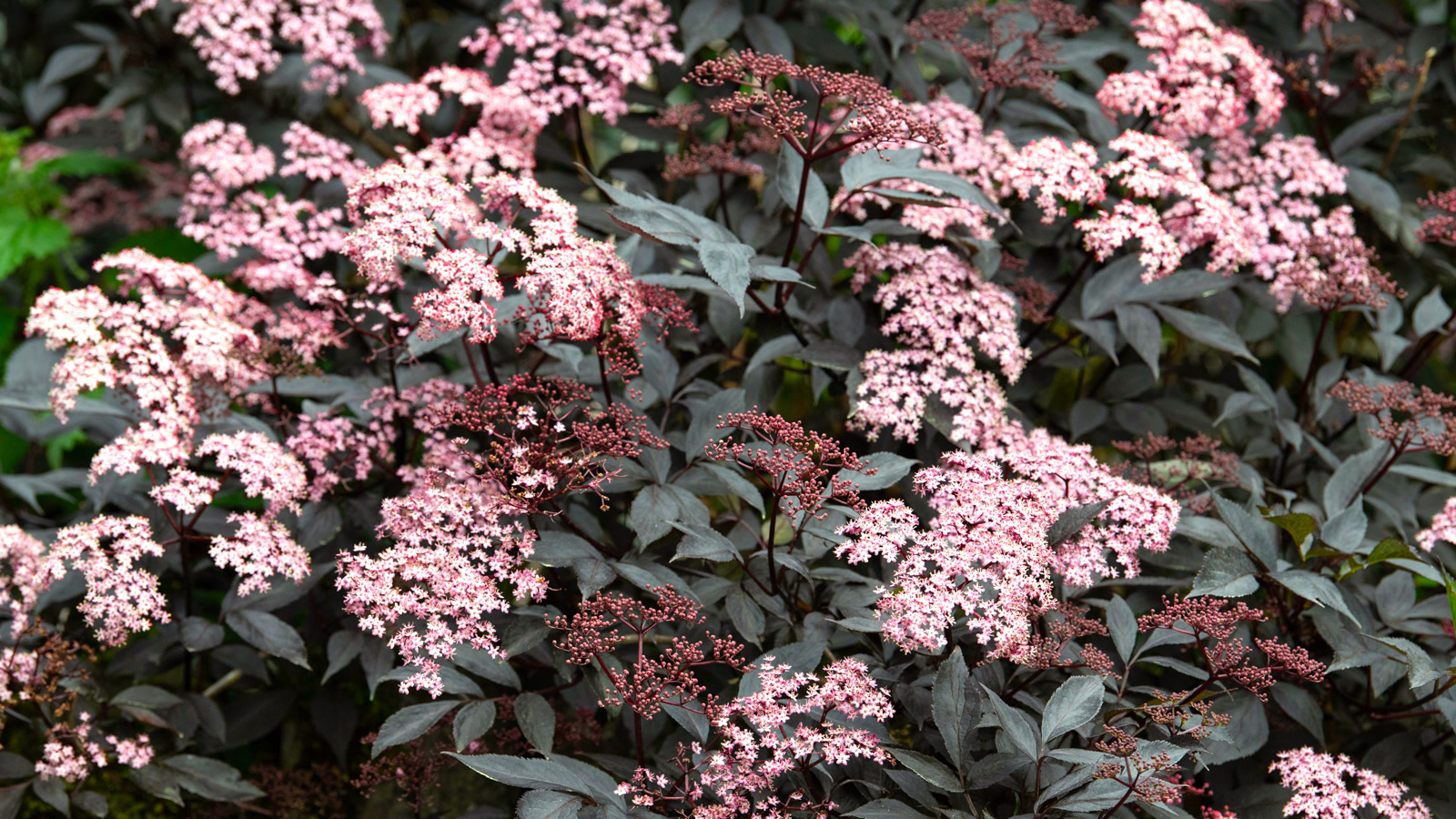
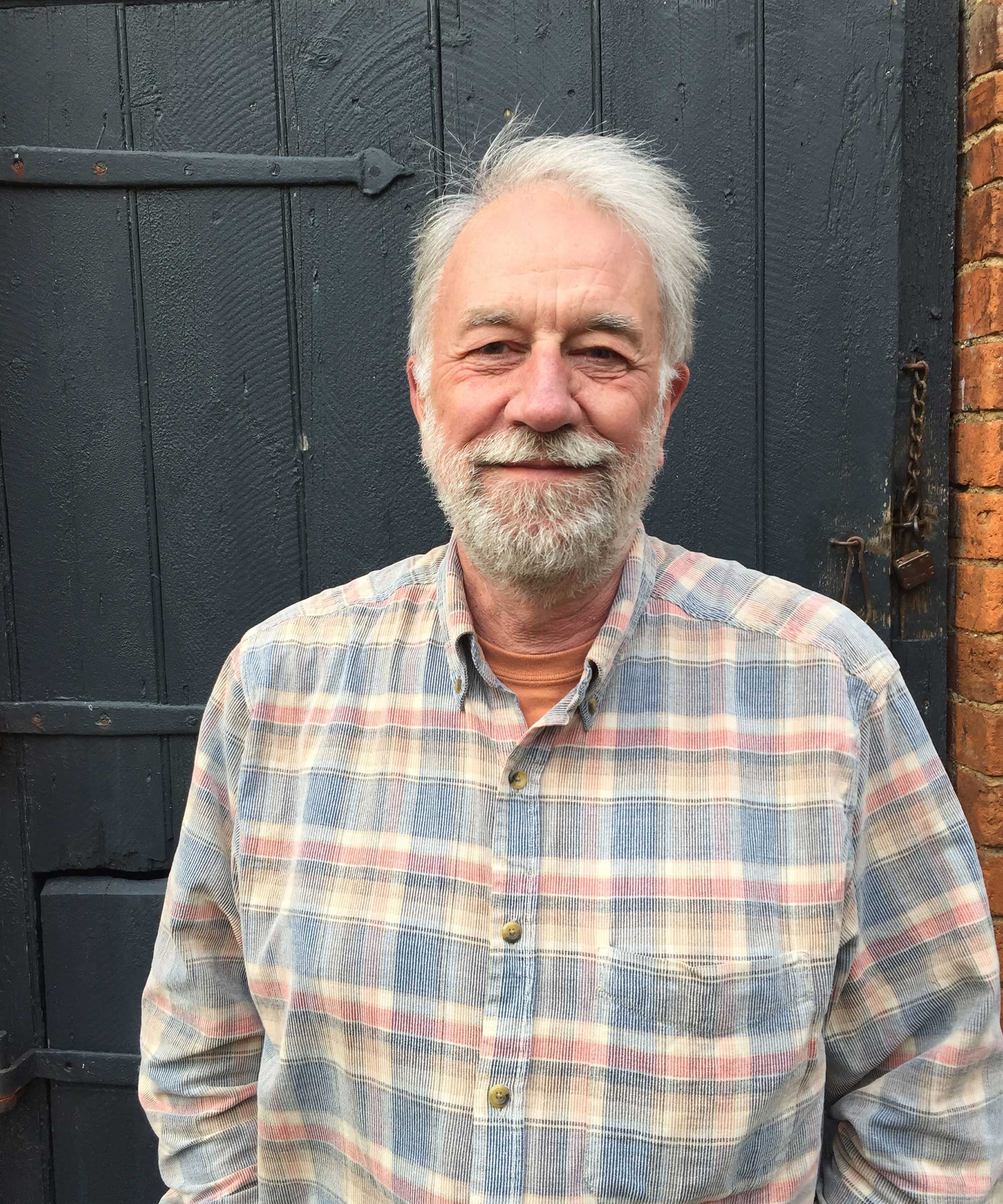
Elder (also known as sambucus) is a bold, adaptable deciduous shrub grown for its leaves, frothy displays of flowers and edible berries. Its foliage could be described as shaped like giant rose leaves, with leaflets arranged in opposite pairs along the central stem, plus one leaflet at the tip. Many modern varieties have leaves that are repeatedly split and toothed and some look as frilly as a Japanese maple.
Foliage color is varied and dramatic: some are bronzed or crimson, while others are gold and a few are variegated. Several would make splendid foliage plants even if they had no other features. Many also have white or creamy flowers on broad, flat or rounded frothy heads (umbels) up to 18in across. These are then followed by small, shiny berries, which are popular in drinks and pies, and appreciated by birds and other wildlife. They aid the immune system, treat inflammation and reduce stress, and contain high levels of vitamins and antioxidants.
In recent years, there has been a revival of interest in growing elder as a flowering shrub and a source of edibles. They are very popular in wildlife and coastal gardens, and as part of dramatic hedging or border planting. Varieties have been developed with very attractive foliage; there are also neat growing, heavily cropping elders developed specifically for their berry crops.
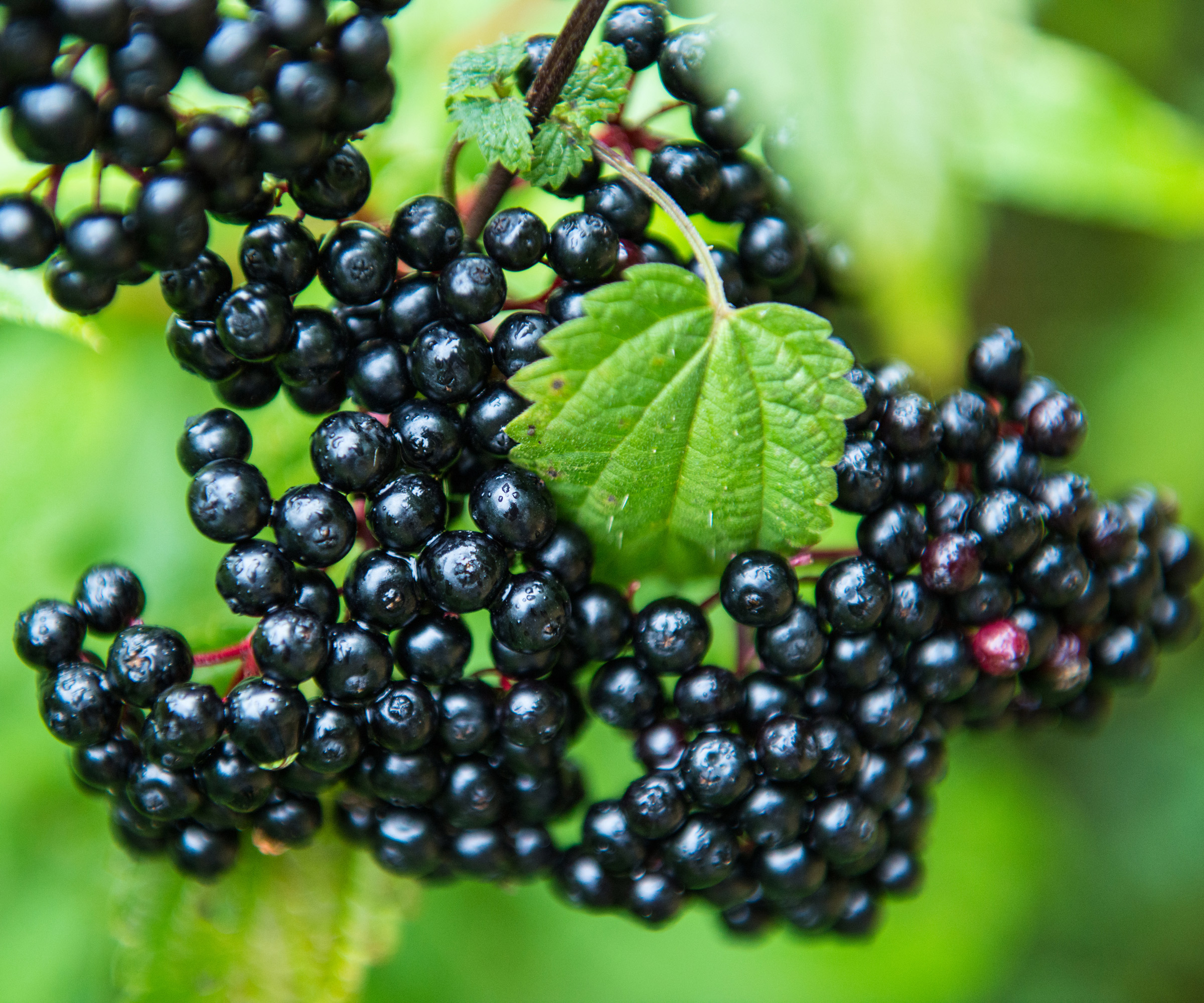
Elder fruits (elderberries) are beneficial and work well in preserves, pies and drinks
Elder: key facts
- Plant type: Deciduous shrub
- Mature size: 4-15ft
- Soil type: Almost any
- Soil PH: Slightly acid, neutral, slightly alkaline, alkaline
- Time of year to plant: Spring, fall
- Flowering time: Spring, summer
- Flower color: White, cream, pink
- Berry color: Black, red
- Hardiness zones: USDA Z3-9
- Scientific name: Sambucus
- Common name: Elder, elderflower, elderberry, blueberry elder, sweet elder
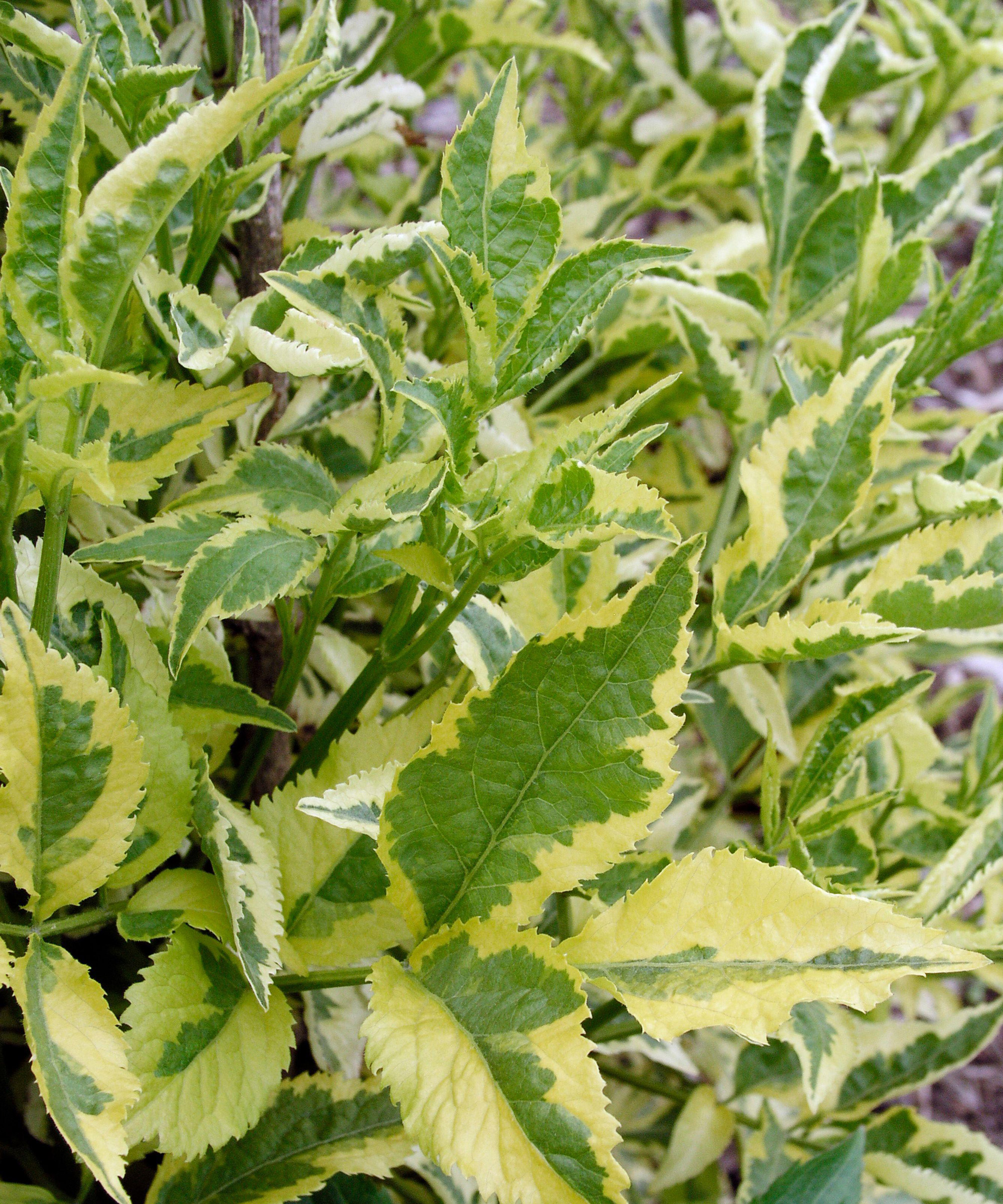
Elder Madonna is one of the best variegated shrubs and can reach 10ft
Identifying the main types of elder
Elders of all kinds make great low maintenance garden border ideas and can be conveniently split into two groups, depending on their origins. One group has its origins in Europe; the other in North America.
This is an important distinction when considering the restoration of natural habitats, creating native wildlife gardens and so on. If you are interested in coastal plants, the best hedges for wildlife or the best privacy hedges, this factor may have a bearing on suitability. That said, many breeds are easy going and work in a range of situations.
- American elders: Two different elders grow in North America; the American elder (Sambucus canadensis) with blue-black berries, and the red elder, (S. racemosa). The American elder matures as a much smaller plant than the European type. It flowers a month later in midsummer, and its berries have a bluish tint. The red elder has creamier spring flowers in conical spikes rather than flat heads, followed by red berries.
- European elders: The European elder (S. nigra) is a deciduous shrub or small tree growing in a wide variety of habitats across the British Isles. Clusters of sweetly scented white flowers are followed by black berries. Bird-sown seeds sometimes sprout in cracks in old brickwork and unexpected places. Many varieties have been introduced, some with prettily shaped or colored foliage, or unusually large heads of flowers or berries.
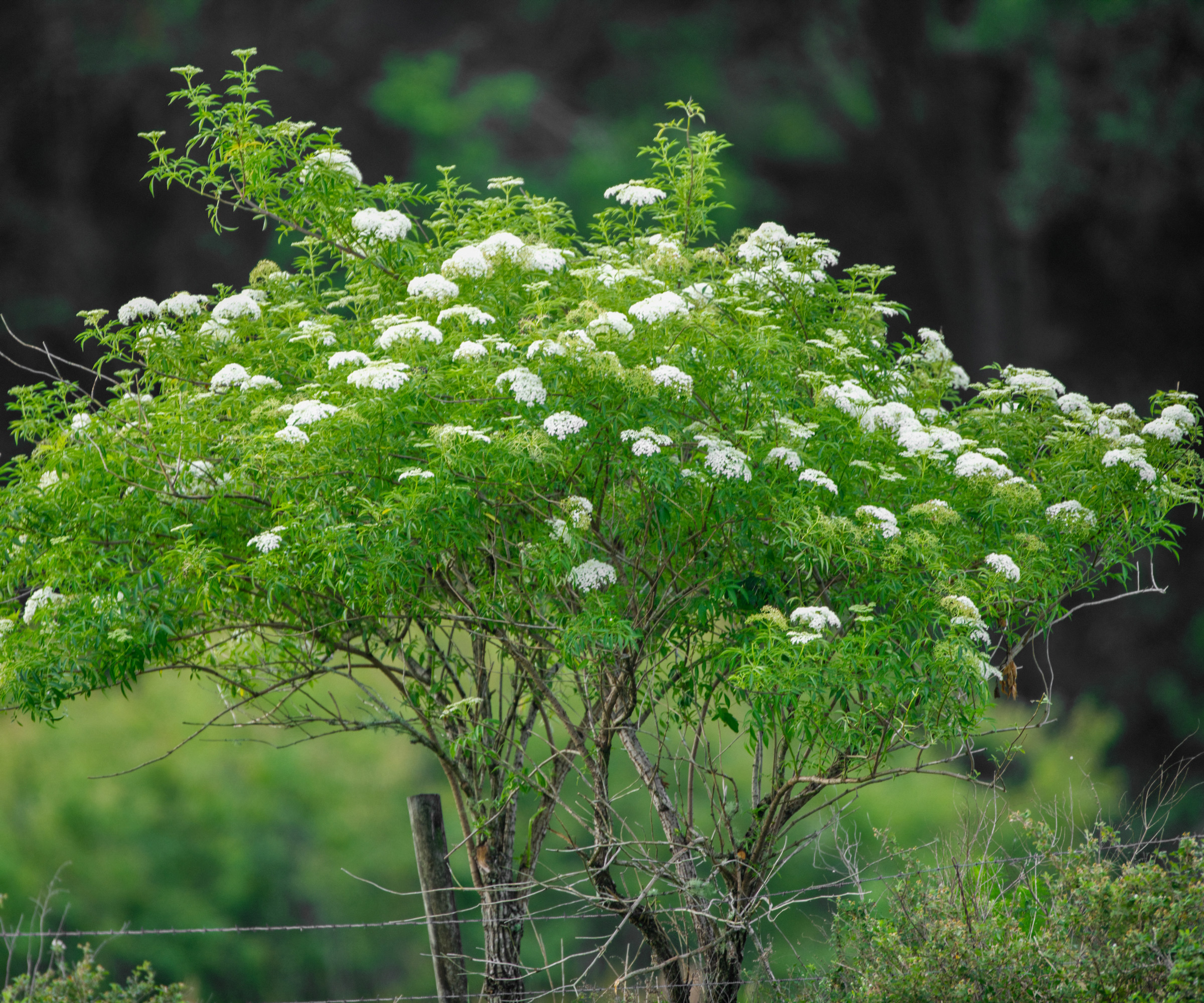
American elderberry matures as a shrub rather than a tree
Choosing the right elder for your garden
The good news for those who fancy growing elder is that most gardens should accommodate their bushy growth, frothy flowerheads and shiny fruits. When choosing an elder for ornamental purposes, the two main features to consider are foliage and flowers.
For those interested in following garden color schemes, there are some striking variations in both camps. While many varieties are white flowering with black fruits, there are several popular breeds with purple leaves and pink blooms.
Some of the most popular and widely available are listed below:
- Elders for foliage: For those who like purple plants, one of the best new shrubs is Sambucus Black Lace (‘Eva’), from Monrovia – a strong-growing elder with deep purple lacy foliage like a cut-leaved maple, plus flat heads of pink flowers. Black Beauty (‘Gerda’) is similar but with broader foliage. Laced Up (‘Snr1292’) and Black Tower (‘Eiffel 1’) from Monrovia are two upright dark-leaved varieties. ‘Aurea’ has soft golden yellow leaves and red berries, while Lemony Lace (‘Smnsrd4’) from Nature Hills has a more golden look, with reddish shoot tips. Instant Karma (‘Sanivalk’) is the best of the variegated sorts, with a creamy edge to each green leaf. Serenade (‘Jonade’) has heavily toothed leaves that open pink and mature to yellow-green, then turn red in the fall.
- Elders for flowers: The tiny, starry elder flowers are held up to 5-8in across in wild forms, but up to 18in across in some garden varieties and hybrids. They often have a sweet fragrance and are used in cordials and ‘champagnes’. Most make pretty accents in white garden ideas as they bloom in white or cream. However, dark-leaved varieties like Laced Up, available from Proven Winners tend to have pink flowers. The flower heads of the European elder are flat, while those of the American type are convex in shape and the heads of the red-berried elder are conical.
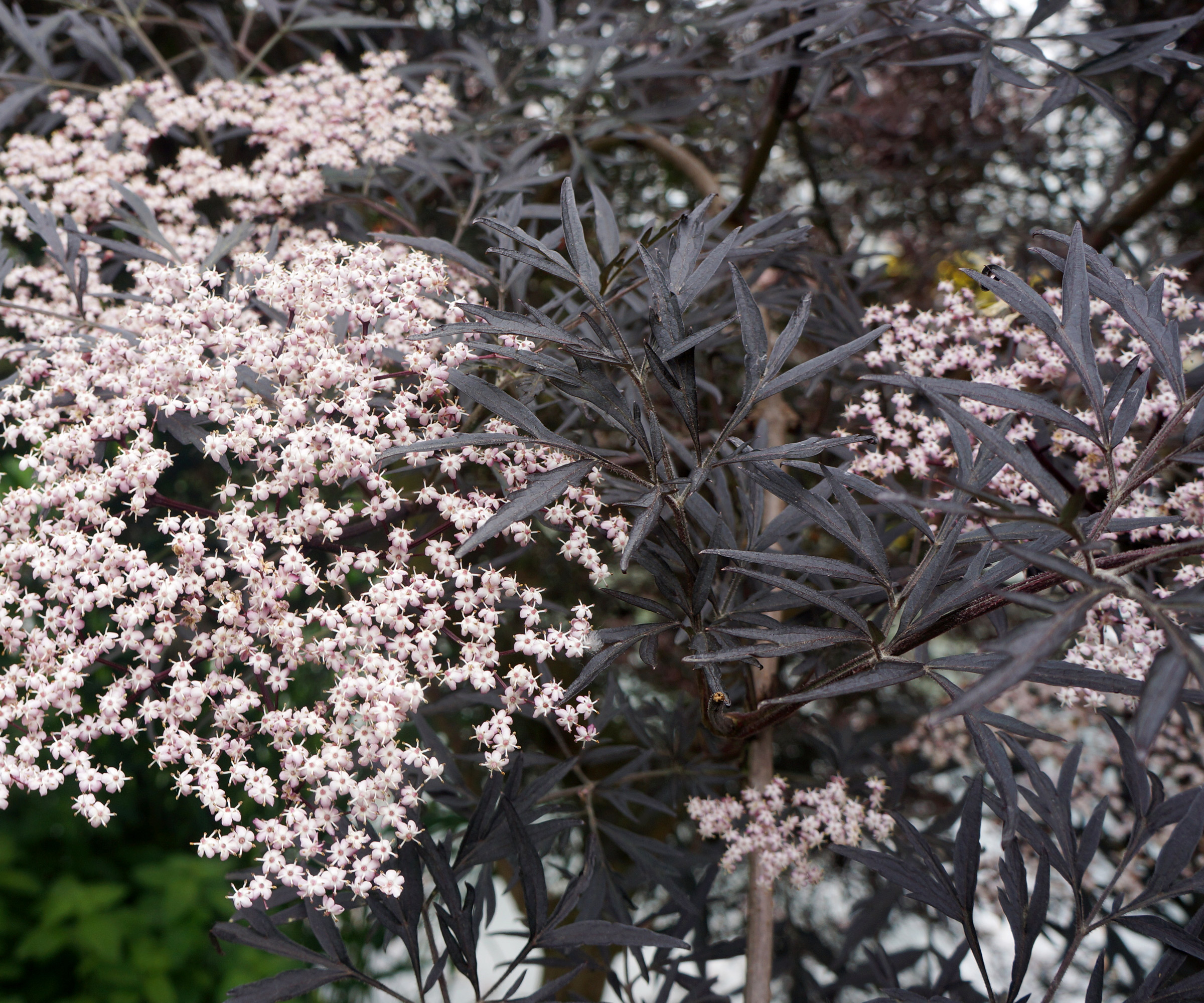
Black Lace has broad heads of lightly scented flowers from June to July
Where, when and how to plant elder
Elders are best planted in early spring, as soon as any frost has gone out of the ground or any waterlogged soils have dried out a little. You may find it helps to check soil health to make sure plants don’t struggle or fall foul of rots. That said, sambucus are strong growing and adaptable. They can also be planted in summer; just be sure to irrigate during dry spells as they can dry out quickly. They can also be planted in early fall.
These shrubs are a good choice for soils with a high lime content but, having said that, hardy elders are tolerant of most situations. They will grow almost anywhere in sun or partial shade, and in most conditions as long as they are not left to get parched. Upright elders work well at the back of the flower garden, while bushier types are ideal for delicate wildlife garden ideas, informal hedges and screens or coastal gardens where you need a shrub that does not demand much care. Small varieties are also good in containers as well as borders.
Knowing how to grow elder does not require you to learn any special shrub planting treatments. They usually grow strongly from soon after planting. However, it pays to fertilize your new elder in its pot, at least an hour or two before planting, and again after planting. Add organic compost or humus when preparing the planting site. This will provide nutrients and help prevent drying out.
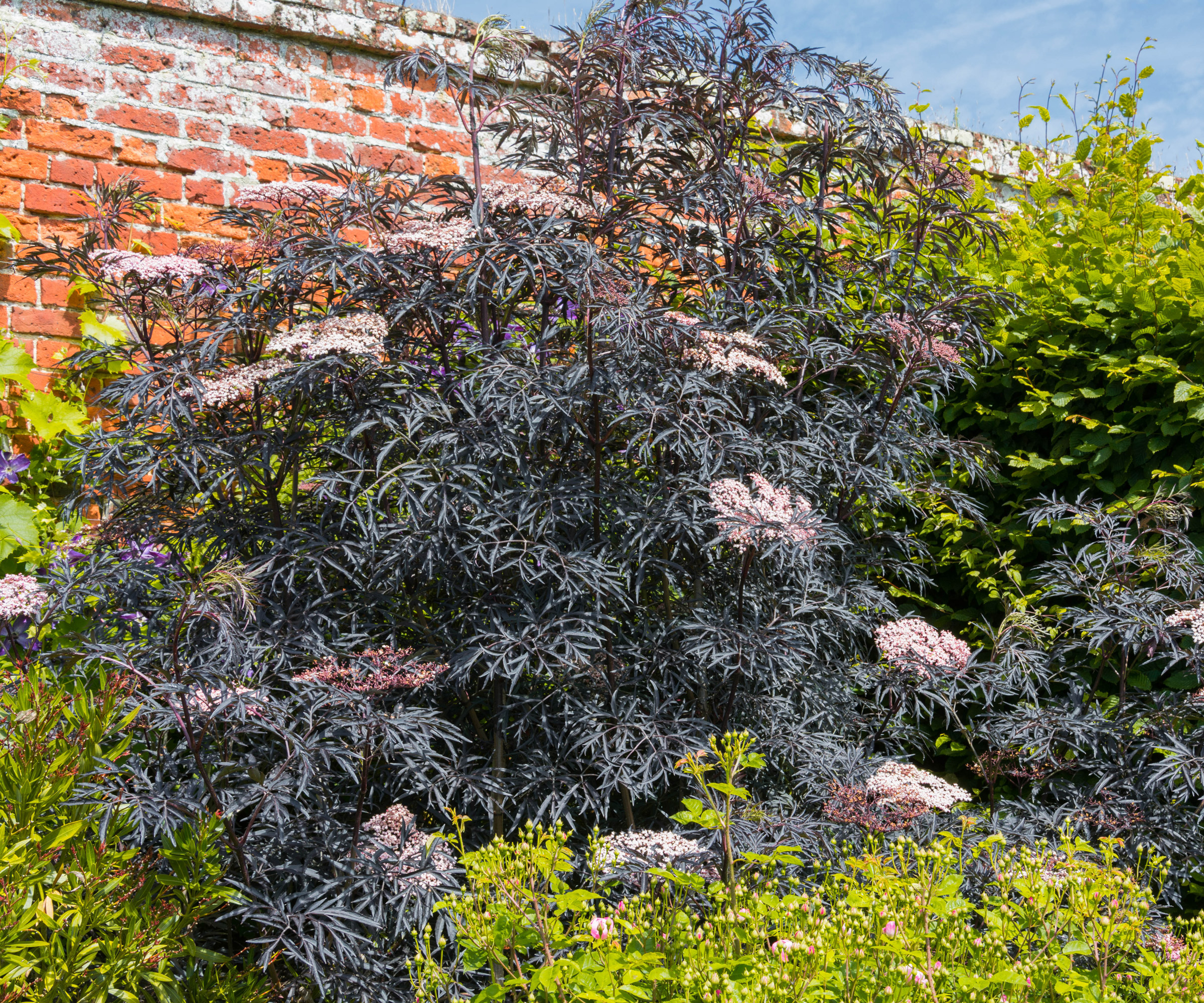
Ideal for the back of borders, the dark-leaved varieties are useful for providing a contrast of color
Caring for elder
Once you have planted your elder, you will find it is one of the ultimate ‘let-them-get-on-with-it’ plants. However, regular feeding, irrigation and pruning will greatly improve their shape, the quality of their foliage, their flower power and their crop of berries. You should water plants well in dry summers, preferably using a drip system and not a lawn sprinkler which wastes water. A spring treatment of shrub fertilizer will help promote strong growth, especially if you will be pruning regularly.
If you prefer not to attract pigeons to your yard, or to have berries staining your paths and patios, deadhead promptly after flowering. And if your elder becomes too large for its location, there are two solutions. Propagate some young plants from hardwood cuttings (see below), then dig up and discard the plant that has grown too large and replace it with the younger plant. Alternatively, prune the elderberry bush to 12-18in above ground level in spring; it will sprout strongly.
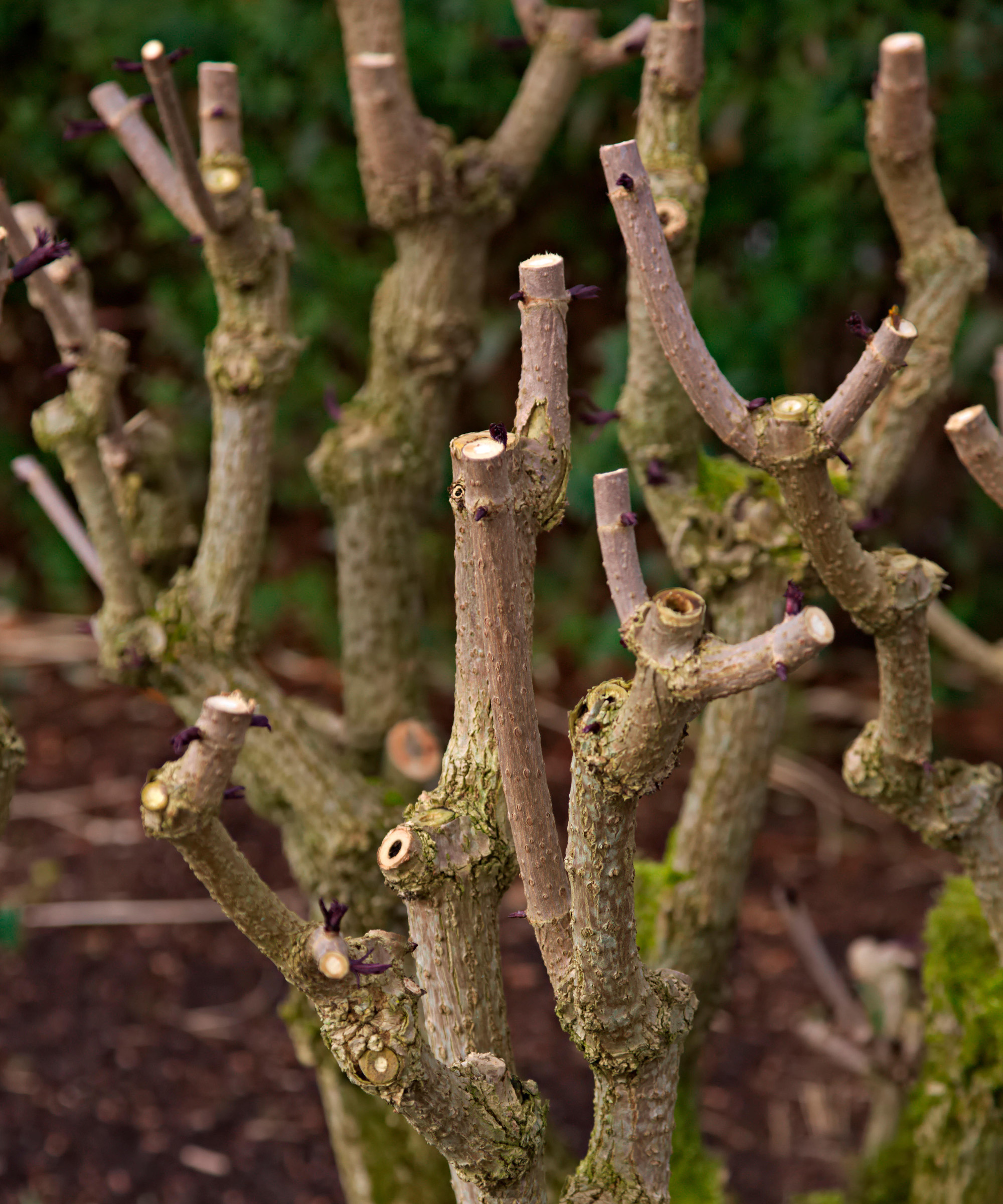
Elder can be cut back hard in early spring
How to take elder cuttings
If you enjoy growing elder and fancy making some more, you’re in luck. Taking plant cuttings is a great way to create more plants for free. They are easy to propagate from hardwood cuttings taken in late fall or early spring, when the elder has lost its leaves and is dormant.
Here’s how to make your own hardwood cutting and ensure they take effectively:
- Look for straight stems 9-12in long, with no side-shoots, and the thickness of a pencil. Trim each cutting with an angled cut just above the top leaf joint and a horizontal cut just below the lowest leaf joint.
- Fill a gallon- or two-gallon container with potting soil. Tap the base on the ground to settle the mix. Push each cutting into the potting soil about halfway; the angle of cuts reminds you which way to insert your cutting.
- Insert the cuttings 3in apart. Tap the pot on the ground to settle it. Water until the water seeps out of the drainage holes. Place the pot in a bright, sheltered place outside. Water in dry spells when there is no frost.
- As spring develops, roots should grow from the base of the pot and new shoots from the tips of the elder cuttings. Knock the soil out of the pot, carefully pull the rooted cutting apart, and plant each in its new home.
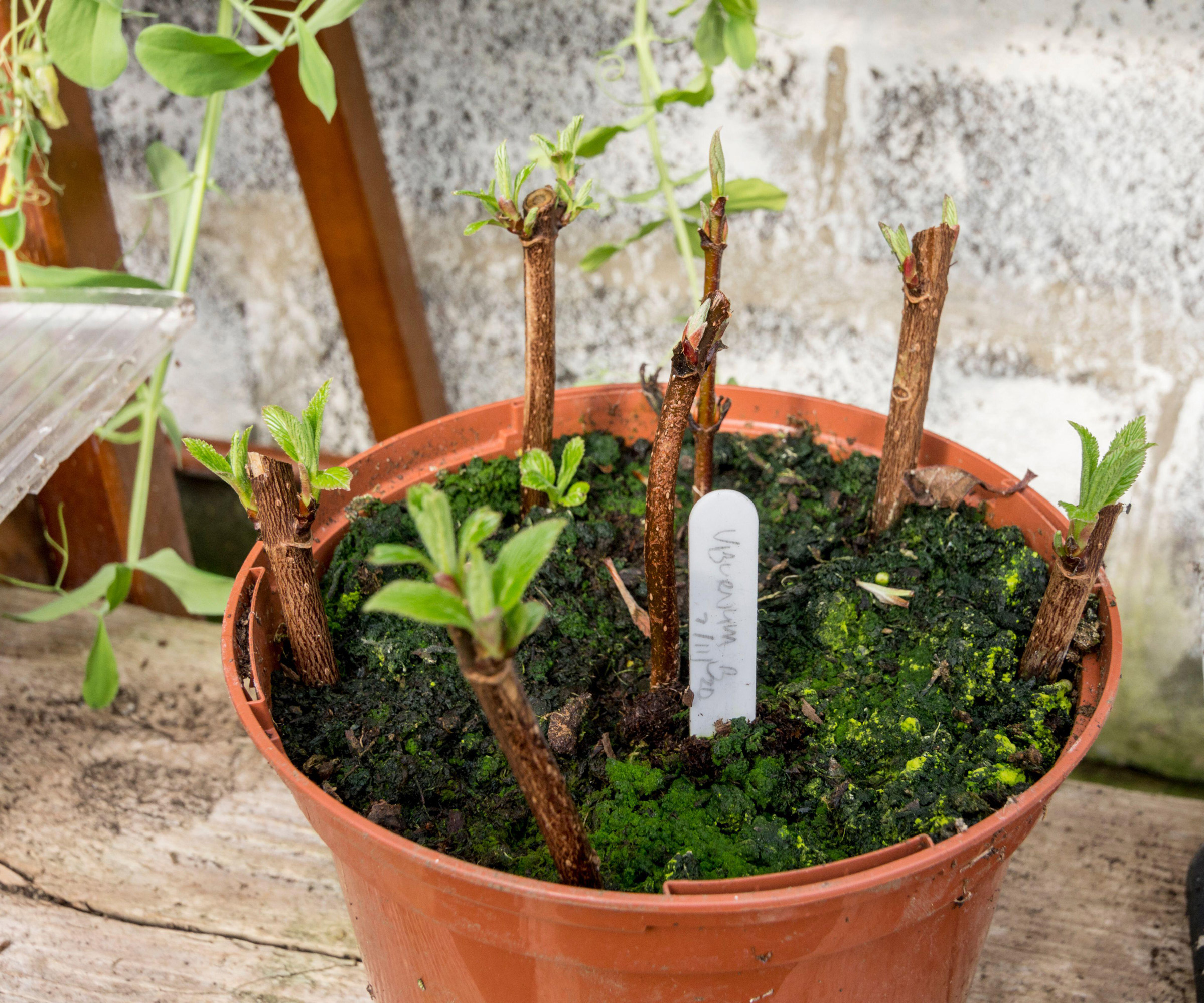
Hardwood cuttings taken in fall, showing signs of growth in spring
Key problems and how to solve them
The beauty of growing elder is that they suffer from fewer problems than most shrubs. Furthermore, they are generally tolerant of any that might arise. There are just a few things to watch out for if you want to get the best from your shrubs and ensure healthy flowering and ample fruiting:
- Aphids: Look out for small (usually black) insects on new stems and on the undersides of leaves. These can suck sap, weaken the plant and spread viral disease. To get rid of aphids, add predatory insects like lacewings and ladybugs (avoid the use of broad spectrum sprays). You can also try a blast of water from the hose to knock off pests.
- Root rot: Keep an eye out for wilting or yellowing leaves, or dramatic leaf fall. Root rots are usually the result of poor growing conditions – in particular, continued waterlogging. This is usually the result of planting an elder in the wrong site or a change in local growing conditions. Make new plants from hardwood cuttings and plant in more suitable sites.
- Self-seeding: Many birds enjoy the prolific crops of berries produced by most elders. But they then excrete the seeds which often sprout where they drop. They can be dug up and planted elsewhere while small, but you may prefer to get rid of them. It is easiest to pull them up while they are small. It’s worth growing more plants for birds to act as decoys.

Birds like garden warblers can cause prolific self-seeding that you will need to watch for
Where to buy elder
For those keen to know how to grow elder, several eye-catching varieties can be found in walk-in nurseries, garden centers and the garden departments of DIY stores. These are usually recent varieties such as Black Beauty, Black Lace, Black Tower, Laced Up and Lemony Lace. They are available in gallons (or larger) during spring and summer.
A broader range is available via mail order, including wild types for conservation and restoration planting, and varieties chosen for their edible appeal. Plants are offered in tubes, gallons, two gallon or three gallon containers, and sometimes larger (be sure to check shipping charges before ordering). Use our quick links to find the elder that best suits your garden and planting requirements.
FAQs
Can I grow an elder in a container?
Elder plants make good container gardening ideas for a deck or patio. However, keep in mind that most are vigorous and can get big in a few years unless pruned regularly. Choose a pot made of stone, concrete or another heavy material, so your elder is stable in windy conditions. Plant in fresh potting soil and stand on pot feet for good drainage. Irrigate regularly and add a liquid feed in spring and summer.
Cut-leaved elders such as bronzed Black Lace look especially good in containers. Golden-leaved varieties like Lemony Lace are less vigorous than most, and can be placed in good light (but do not scorch in full sun). Elders can be grown solely for foliage and pruned in spring, or pruned promptly after flowering and again in late summer to keep them neat.
Which parts of elder are edible?
Both flowers and fruits can be consumed, depending on the variety. In America's Garden Book (available at Amazon), Louise and James Bush-Brown note that ripe fruits can be used for preserves and fruit pies, and as the main ingredient in elderflower wine, while half-ripe berries are suitable for jelly.
Look for varieties such as ‘Adams’, ‘York’ and ‘Ranch’, which have been developed with cropping fruit in mind.
Blanched young leaves are good in salads, and flowers can be battered as fritters or used to make a summer cordial. If growing elder for its edibles, just be aware that uncooked berries (and berries that aren’t fully ripe) may cause nausea, vomiting and diarrhoea.
Are elder plants deer resistant?
If you are after deer-resistant plants then you’ll be glad to hear that, generally speaking, elder shrubs are fine. The experts at Rutgers University’s New Jersey Agricultural Experiment Station (NJAES) have assessed both native elders, and rate the red elder (Sambucus racemosa) as ‘Rarely Damaged’ and the blueberry elder (aka sweet elder, American elder or S. canadensis) as ‘Seldom Severely Damaged’. These are the top two categories for deer resistance. The European type (S. nigra) is also generally recognized as deer resistant for anyone looking to grow elder.
Easy to grow and care for, elder are certainly worth considering as a shrub for the front of your house or your backyard.
They are suitable for growing in most soil types and their berries are a valuable source of food for wildlife, plus the flowers and foliage will introduce plenty of color to your planting scheme. If you haven't considered growing one before, maybe now is the time to try.
Sign up to the Homes & Gardens newsletter
Design expertise in your inbox – from inspiring decorating ideas and beautiful celebrity homes to practical gardening advice and shopping round-ups.

Graham Rice is a garden writer who has won awards for his work online, and in books and magazines, on both sides of the Atlantic. He is a member of a number of Royal Horticultural Society committees and the recipient of the 2021 Garden Media Guild Lifetime Achievement Award. He gardened in Pennsylvania for 20 years, but has recently returned to his native England.
-
 Emily Blunt gifted Cillian Murphy this $545 pillow – she's 'obsessed' with these luxury pillows, and frankly, so are we
Emily Blunt gifted Cillian Murphy this $545 pillow – she's 'obsessed' with these luxury pillows, and frankly, so are weThe Oppenheimer stars sleep on this ultra-luxe goose down pillow – here's why we love it – plus our affordable alternatives from $35
By Sophie Edwards Published
-
 The great bedding debate: top sheet vs no top sheet − which side are you on?
The great bedding debate: top sheet vs no top sheet − which side are you on?I asked an expert panel of bedding designers whether you really need a top sheet to keep clean and cool or if it's just another ploy to make you spend money
By Emilia Hitching Published